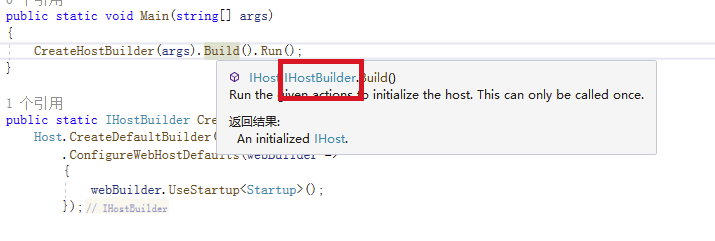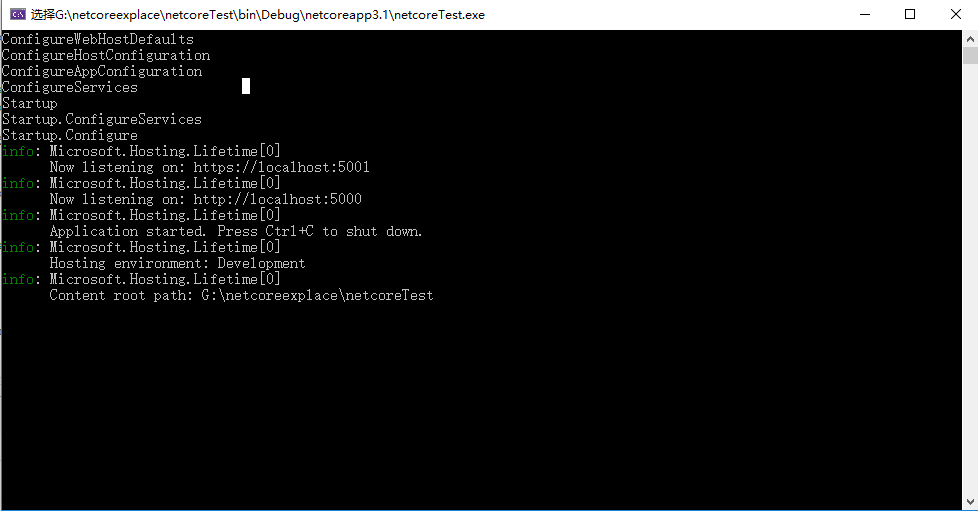重新整理 .net core 实践篇————配置应用[一]
前言
本来想整理到<<重新整理.net core 计1400篇>>里面去,但是后来一想,整理 .net core 实践篇 是偏于实践,故而分开。
因为是重新整理,那么就从配置开始整理。以下只是个人理解,如有错误,望请指点谢谢。
正文
在我们创建好一个应用的时候,那么出现在我们视野的是一个这样的东西:
public class Program
{
public static void Main(string[] args)
{
CreateHostBuilder(args).Build().Run();
}
public static IHostBuilder CreateHostBuilder(string[] args) =>
Host.CreateDefaultBuilder(args)
.ConfigureWebHostDefaults(webBuilder =>
{
webBuilder.UseStartup<Startup>();
});
}
看到这种:
CreateHostBuilder(args).Build().Run();
显然是建设者模式。
那么前面的基本就是在做一个构建。
既然是一个建设者模式,那么就来看一下这个的构建器是什么?

是一个叫做IHOSTBUILDER 的东西哈,而显然从命名上看这是一个接口哈。那么看下这个接口是啥:

跟配置相关得到也就是那几个Configure开头的那4个东西。
后面两个UseServiceProviderFactory后面系列再说。
//
// 摘要:
// Sets up the configuration for the remainder of the build process and application.
// This can be called multiple times and the results will be additive. The results
// will be available at Microsoft.Extensions.Hosting.HostBuilderContext.Configuration
// for subsequent operations, as well as in Microsoft.Extensions.Hosting.IHost.Services.
//
// 参数:
// configureDelegate:
// The delegate for configuring the Microsoft.Extensions.Configuration.IConfigurationBuilder
// that will be used to construct the Microsoft.Extensions.Configuration.IConfiguration
// for the application.
//
// 返回结果:
// The same instance of the Microsoft.Extensions.Hosting.IHostBuilder for chaining.
IHostBuilder ConfigureAppConfiguration(Action<HostBuilderContext, IConfigurationBuilder> configureDelegate);
这个函数的大致意思是说构件一个IConfigurationBuilder,这个the remainder of the build process and application.的配置。
// 摘要:
// Enables configuring the instantiated dependency container. This can be called
// multiple times and the results will be additive.
//
// 参数:
// configureDelegate:
// The delegate which configures the builder.
//
// 类型参数:
// TContainerBuilder:
// The type of builder.
//
// 返回结果:
// The same instance of the Microsoft.Extensions.Hosting.IHostBuilder for chaining.
IHostBuilder ConfigureContainer<TContainerBuilder>(Action<HostBuilderContext, TContainerBuilder> configureDelegate);
依赖容器相关的哈。
ConfigureHostConfiguration 和 ConfigureServices 这两个就不贴了,分别是一些坏境配置和服务配置。
那么启动一下,看下他们的执行顺序是否和我们代码的书写顺序是否相同,也就是说不管我如何调换顺序他们的执行都是按照某种规则。
那么这里加上log,通过log的方式来查看执行顺序,如下:
public class Program
{
public static void Main(string[] args)
{
CreateHostBuilder(args).Build().Run();
}
public static IHostBuilder CreateHostBuilder(string[] args) =>
Host.CreateDefaultBuilder(args)
.ConfigureAppConfiguration((builder) =>
{
Console.WriteLine("ConfigureAppConfiguration");
}).ConfigureServices(builder =>
{
Console.WriteLine("ConfigureServices");
}).ConfigureHostConfiguration(builder =>
{
Console.WriteLine("ConfigureHostConfiguration");
})
.ConfigureWebHostDefaults(webBuilder =>
{
Console.WriteLine("ConfigureWebHostDefaults");
webBuilder.UseStartup<Startup>();
});
}
startup.cs
public class Startup
{
public IConfiguration Configuration { get; }
public Startup(IConfiguration configuration)
{
Console.WriteLine("Startup");
Configuration = configuration;
}
// This method gets called by the runtime. Use this method to add services to the container.
// For more information on how to configure your application, visit https://go.microsoft.com/fwlink/?LinkID=398940
public void ConfigureServices(IServiceCollection services)
{
Console.WriteLine("Startup.ConfigureServices");
services.AddControllers();
}
// This method gets called by the runtime. Use this method to configure the HTTP request pipeline.
public void Configure(IApplicationBuilder app, IWebHostEnvironment env)
{
Console.WriteLine("Startup.Configure");
if (env.IsDevelopment())
{
app.UseDeveloperExceptionPage();
}
app.UseRouting();
app.UseEndpoints(endpoints =>
{
endpoints.MapGet("/", async context =>
{
await context.Response.WriteAsync("Hello World!");
});
});
}
}

这里可以发现执行顺序和我们的代码的书写顺序并不是一致的。
那么我们再次做一个小小的调换,那么会怎么样呢?
public static IHostBuilder CreateHostBuilder(string[] args) =>
Host.CreateDefaultBuilder(args)
.ConfigureWebHostDefaults(webBuilder =>
{
Console.WriteLine("ConfigureWebHostDefaults");
webBuilder.UseStartup<Startup>();
})
.ConfigureServices(builder =>
{
Console.WriteLine("ConfigureServices");
})
.ConfigureAppConfiguration((builder) =>
{
Console.WriteLine("ConfigureAppConfiguration");
})
.ConfigureHostConfiguration(builder =>
{
Console.WriteLine("ConfigureHostConfiguration");
});
}

发现变化的只有Startup.ConfigureServices 和 ConfigureServices。
这个时候我们大体猜出来了这个启动顺序是按照某种执行顺序执行,且Startup.ConfigureServices 和 ConfigureServices 是同一种类型,并且他们的执行顺序和他们的注册顺序保持一致。
执行顺序如下:

先看一下CreateDefaultBuilder:
public static IHostBuilder CreateDefaultBuilder(string[] args)
{
var builder = new HostBuilder();
builder.UseContentRoot(Directory.GetCurrentDirectory());
builder.ConfigureHostConfiguration(config =>
{
config.AddEnvironmentVariables(prefix: "DOTNET_");
if (args != null)
{
config.AddCommandLine(args);
}
});
builder.ConfigureAppConfiguration((hostingContext, config) =>
{
var env = hostingContext.HostingEnvironment;
config.AddJsonFile("appsettings.json", optional: true, reloadOnChange: true)
.AddJsonFile($"appsettings.{env.EnvironmentName}.json", optional: true, reloadOnChange: true);
if (env.IsDevelopment() && !string.IsNullOrEmpty(env.ApplicationName))
{
var appAssembly = Assembly.Load(new AssemblyName(env.ApplicationName));
if (appAssembly != null)
{
config.AddUserSecrets(appAssembly, optional: true);
}
}
config.AddEnvironmentVariables();
if (args != null)
{
config.AddCommandLine(args);
}
})
.ConfigureLogging((hostingContext, logging) =>
{
var isWindows = RuntimeInformation.IsOSPlatform(OSPlatform.Windows);
// IMPORTANT: This needs to be added *before* configuration is loaded, this lets
// the defaults be overridden by the configuration.
if (isWindows)
{
// Default the EventLogLoggerProvider to warning or above
logging.AddFilter<EventLogLoggerProvider>(level => level >= LogLevel.Warning);
}
logging.AddConfiguration(hostingContext.Configuration.GetSection("Logging"));
logging.AddConsole();
logging.AddDebug();
logging.AddEventSourceLogger();
if (isWindows)
{
// Add the EventLogLoggerProvider on windows machines
logging.AddEventLog();
}
})
.UseDefaultServiceProvider((context, options) =>
{
var isDevelopment = context.HostingEnvironment.IsDevelopment();
options.ValidateScopes = isDevelopment;
options.ValidateOnBuild = isDevelopment;
});
return builder;
}
那么先看下ConfigureWebDefaults 到底干了什么。
internal static void ConfigureWebDefaults(IWebHostBuilder builder)
{
builder.ConfigureAppConfiguration((ctx, cb) =>
{
if (ctx.HostingEnvironment.IsDevelopment())
{
StaticWebAssetsLoader.UseStaticWebAssets(ctx.HostingEnvironment, ctx.Configuration);
}
});
builder.UseKestrel((builderContext, options) =>
{
options.Configure(builderContext.Configuration.GetSection("Kestrel"));
})
.ConfigureServices((hostingContext, services) =>
{
// Fallback
services.PostConfigure<HostFilteringOptions>(options =>
{
if (options.AllowedHosts == null || options.AllowedHosts.Count == 0)
{
// "AllowedHosts": "localhost;127.0.0.1;[::1]"
var hosts = hostingContext.Configuration["AllowedHosts"]?.Split(new[] { ';' }, StringSplitOptions.RemoveEmptyEntries);
// Fall back to "*" to disable.
options.AllowedHosts = (hosts?.Length > 0 ? hosts : new[] { "*" });
}
});
// Change notification
services.AddSingleton<IOptionsChangeTokenSource<HostFilteringOptions>>(
new ConfigurationChangeTokenSource<HostFilteringOptions>(hostingContext.Configuration));
services.AddTransient<IStartupFilter, HostFilteringStartupFilter>();
if (string.Equals("true", hostingContext.Configuration["ForwardedHeaders_Enabled"], StringComparison.OrdinalIgnoreCase))
{
services.Configure<ForwardedHeadersOptions>(options =>
{
options.ForwardedHeaders = ForwardedHeaders.XForwardedFor | ForwardedHeaders.XForwardedProto;
// Only loopback proxies are allowed by default. Clear that restriction because forwarders are
// being enabled by explicit configuration.
options.KnownNetworks.Clear();
options.KnownProxies.Clear();
});
services.AddTransient<IStartupFilter, ForwardedHeadersStartupFilter>();
}
services.AddRouting();
})
.UseIIS()
.UseIISIntegration();
}
ConfigureWebDefaults 配置了一些必要的组件。
CreateDefaultBuilder 和 ConfigureWebDefaults 两者可以看到其实就是做一些默认配置让我们的服务能够启动起来。
而后续的配置也就是注册的顺序执行,只是我们的执行顺序晚点罢了。
那么再整理一下,也就是说从原理的执行顺序来说是这样的。
ConfigureHostConfiguration
ConfigureAppConfiguration
ConfigureServices
ConfigureLogging
Configure
以上都是推论。那么直接看源码,因为是构建者模式,所以直接看build。
public IHost Build()
{
if (_hostBuilt)
{
throw new InvalidOperationException("Build can only be called once.");
}
_hostBuilt = true;
BuildHostConfiguration();
CreateHostingEnvironment();
CreateHostBuilderContext();
BuildAppConfiguration();
CreateServiceProvider();
return _appServices.GetRequiredService<IHost>();
}
上面的顺序和猜想是一致的。
这里看下BuildHostConfiguration:
private List<Action<IConfigurationBuilder>> _configureHostConfigActions = new List<Action<IConfigurationBuilder>>();
private void BuildHostConfiguration()
{
var configBuilder = new ConfigurationBuilder()
.AddInMemoryCollection(); // Make sure there's some default storage since there are no default providers
foreach (var buildAction in _configureHostConfigActions)
{
buildAction(configBuilder);
}
_hostConfiguration = configBuilder.Build();
}
那么其实我们按照这种配置,那么其实我们的ConfigureHostConfiguration全部方法都是在_configureHostConfigActions 中,到了builder 的时候就按照我们的注册顺序执行。
那么这里就能解释ConfigureWebHostDefaults 不管顺序都是在最前面,而里面startup的顺序确不一样。
代码解释一波:
public static IHostBuilder ConfigureWebHostDefaults(this IHostBuilder builder, Action<IWebHostBuilder> configure)
{
return builder.ConfigureWebHost(webHostBuilder =>
{
WebHost.ConfigureWebDefaults(webHostBuilder);
configure(webHostBuilder);
});
}
ConfigureWebHostDefaults 立即执行,那么log自然就先打印出来了,而其他几个都是延迟执行的。他们的执行顺序和注册顺序有关。
最后再解释一下,webBuilder.UseStartup(); 到底做了什么?
public static IWebHostBuilder UseStartup(this IWebHostBuilder hostBuilder, Type startupType)
{
var startupAssemblyName = startupType.GetTypeInfo().Assembly.GetName().Name;
hostBuilder.UseSetting(WebHostDefaults.ApplicationKey, startupAssemblyName);
// Light up the GenericWebHostBuilder implementation
if (hostBuilder is ISupportsStartup supportsStartup)
{
return supportsStartup.UseStartup(startupType);
}
return hostBuilder
.ConfigureServices(services =>
{
if (typeof(IStartup).GetTypeInfo().IsAssignableFrom(startupType.GetTypeInfo()))
{
services.AddSingleton(typeof(IStartup), startupType);
}
else
{
services.AddSingleton(typeof(IStartup), sp =>
{
var hostingEnvironment = sp.GetRequiredService<IHostEnvironment>();
return new ConventionBasedStartup(StartupLoader.LoadMethods(sp, startupType, hostingEnvironment.EnvironmentName));
});
}
});
}
解释一下IsAssignableFrom:
bool res = {TypeA}.IsAssignableFrom({TypeB}) ;
如果TypeA和TypeB类型一样则返回true;
如果TypeA是TypeB的父类则返回true;
如果TypeB实现了接口TypeA则返回true;
可以看到这里做的是一个IStartup 到 Startup的一个依赖注入,且是单例模式,所以肯定的是Startup 里面的方法会在ConfigureHostConfiguration、ConfigureAppConfiguration之后执行,因为其在ConfigureServices 才开始注入依赖的。
结
因为是应用篇,单纯是一些应用需要知道的,所以比较粗糙,具体的详细在原理篇介绍了。上述只是个人的理解,如果错误,望请指点,谢谢。
重新整理 .net core 实践篇————配置应用[一]的更多相关文章
- 重新整理 .net core 实践篇————配置系统之盟约[五]
前言 在asp .net core 中我们会看到一个appsettings.json 文件,它就是我们在服务中的各种配置,是至关重要的一部门. 不管是官方自带的服务,还是我们自己编写的服务都是用它来实 ...
- 重新整理 .net core 实践篇—————配置系统之军令状[七](配置文件)
前言 介绍一下配置系统中的配置文件,很多服务的配置都写在配置文件中,也是配置系统的大头. 正文 在asp .net core 提供了下面几种配置文件格式的读取方式. Microsoft.extensi ...
- 重新整理 .net core 实践篇—————配置系统之间谍[八](文件监控)
前言 前文提及到了当我们的配置文件修改了,那么从 configurationRoot 在此读取会读取到新的数据,本文进行扩展,并从源码方面简单介绍一下,下面内容和前面几节息息相关. 正文 先看一下,如 ...
- 重新整理 .net core 实践篇—————配置系统之强类型配置[十]
前言 前文中我们去获取value值的时候,都是通过configurationRoot 来获取的,如configurationRoot["key"],这种形式. 这种形式有一个不好的 ...
- 重新整理 .net core 实践篇————配置系统——军令(命令行)[六]
前言 前文已经基本写了一下配置文件系统的一些基本原理.本文介绍一下命令行导入配置系统. 正文 要使用的话,引入Microsoft.extensions.Configuration.commandLin ...
- 重新整理 .net core 实践篇—————配置系统之简单配置中心[十一]
前言 市面上已经有很多配置中心集成工具了,故此不会去实践某个框架. 下面链接是apollo 官网的教程,实在太详细了,本文介绍一下扩展数据源,和简单翻翻阅一下apollo 关键部分. apollo 服 ...
- 重新整理 .net core 实践篇————配置中心[四十三]
前言 简单整理一下配置中心. 正文 什么时候需要配置中心? 多项目组并行协作 运维开发分工职责明确 对风险控制有更高诉求 对线上配置热更新有诉求 其实上面都是套话,如果觉得项目不方便的时候就需要用配置 ...
- 重新整理 .net core 实践篇—————服务与配置之间[十一二]
前言 前面基本介绍了,官方对于asp .net core 设计配置和设计服务的框架的一些思路.看下服务和配置之间是如何联系的吧. 正文 服务: public interface ISelfServic ...
- 重新整理 .net core 实践篇————依赖注入应用[二]
前言 这里介绍一下.net core的依赖注入框架,其中其代码原理在我的另一个整理<<重新整理 1400篇>>中已经写了,故而专门整理应用这一块. 以下只是个人整理,如有问题, ...
随机推荐
- Ubuntu之软件包管理 (最全最精)
Centos与Ubuntu的关系 * CentOS之前的地位:Fedora稳定版-->发布-->RHEL稳定版-->发布-->CentOS * CentOS如今的地位:Fedo ...
- 爬虫入门到放弃系列07:js混淆、eval加密、字体加密三大反爬技术
前言 如果再说IP请求次数检测.验证码这种最常见的反爬虫技术,可能大家听得耳朵都出茧子了.当然,也有的同学写了了几天的爬虫,觉得爬虫太简单.没有啥挑战性.所以特地找了三个有一定难度的网站,希望可以有兴 ...
- HTML(〇):简介导读
网页 什么是网页 网站(Website):是指在因特网上根据一定的规则,使用HTML(标准通用标记语言)等工具制作的用于展示特定内容相关网页的集合. 网页(webpage):是网站中的一页,通常是HT ...
- OO第一单元作业——魔幻求导
简介 本单元作业分为三次 第一次作业:需要完成的任务为简单多项式导函数的求解. 第二次作业:需要完成的任务为包含简单幂函数和简单正余弦函数的导函数的求解. 第三次作业:需要完成的任务为包含简单幂函数和 ...
- 【剑指offer】9:变态跳台阶
题目描述: 一只青蛙一次可以跳上1级台阶,也可以跳上2级--它也可以跳上n级.求该青蛙跳上一个n级的台阶总共有多少种跳法. 解题思路: 先考虑最简单情况就是只有一级台阶,仅有一种跳法.两级台阶,有两种 ...
- 【全网首发】鸿蒙开源三方组件--跨平台自适应布局yoga组件
目录: 1.介绍 2.如何使用 3.集成方式 4.附录1:FlexBox科普 5.附录2:相关资料 介绍 yoga是facebook打造的一个跨IOS.Android.Window平台在内的布局引擎, ...
- Java集合原理分析和知识点大杂烩(多图初学者必备!!)
一.数据结构 数据结构就是计算机存储.组织数据的方式. 在计算机科学中,算法的时间复杂度是一个函数,它定性描述了该算法的运行时间,常用O符号来表述. 时间复杂度是同一问题可用不同算法解决, ...
- [ Laravel 5.6 文档 ] 进阶系列 —— 任务调度
简介 Cron 是 UNIX.SOLARIS.LINUX 下的一个十分有用的工具,通过 Cron 脚本能使计划任务定期地在系统后台自动运行.这种计划任务在 UNIX.SOLARIS.LINUX下术语为 ...
- hdu2067 简单dp或者记忆化搜索
题意: 小兔的棋盘 Time Limit: 1000/1000 MS (Java/Others) Memory Limit: 32768/32768 K (Java/Others) Total Sub ...
- 基于frida框架Hook native中的函数(1)
作者:H01mes撰写的这篇关于frida框架hook native函数的文章很不错,值得推荐和学习,也感谢原作者. 0x01 前言 关于android的hook以前一直用的xposed来hook j ...
